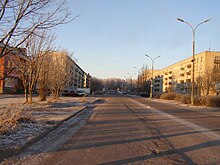Pitkjaranta
city
|
||||||||||||||||||||||||||||||||||||||||
|
||||||||||||||||||||||||||||||||||||||||
|
||||||||||||||||||||||||||||||||||||||||
| List of cities in Russia | ||||||||||||||||||||||||||||||||||||||||
Pitkjaranta ( Russian Питкяранта , Karelian Pitkyrandu , Finnish Pitkäranta ) is a city in the Republic of Karelia ( Russia ) with 11,429 inhabitants (as of October 14, 2010).
geography
The city is located about 170 kilometers west of the republic capital Petrozavodsk, elongated on the northeast bank of Lake Ladoga .
Pitkjaranta is the administrative center of the raion of the same name .
The city is located on the Janisjarwi - Lodeinoje Pole railway line .
history
A village Pitkjaranta on the east bank of Lake Ladoga was first mentioned in the 18th century. The name means roughly long bank in Karelian . At that time the place belonged to the municipality Impilahti (today Impilachti ). In the 19th century there was a shipping pier in Pitkjaranta, which is also known in the Russian form of the name Dolgi Bereg . When Finland gained independence in 1918, the town became part of what was then the Finnish province of Viipuri . In 1932 it was reached by the railway line from Jänisjärvi - Läskelä .
As a result of the Winter War , Pitkjaranta was conquered by the Soviet Union in 1940, along with most of Western Karelia . In World War II pitkyaranta was recaptured by Finnish troops on July 17, 1941 and July 10, 1944 by troops of the Karelian Front of the Red Army during the Svir-Petrozavodsk operation reoccupied.
In the city there was a prisoner of war camp 166 for German prisoners of war of the Second World War.
Population development
| year | Residents |
|---|---|
| 1959 | 6,204 |
| 1970 | 10,251 |
| 1979 | 13,839 |
| 1989 | 14,361 |
| 2002 | 13,347 |
| 2010 | 11,429 |
Note: census data
Culture and sights
The city has a local museum.
economy
The economy of the city of Pitkjaranta is determined by the wood and wood processing industry (cellulose and paper mill).
12 kilometers from the city, red granite has been mined on the island of German in Lake Ladoga since the end of the 19th century , also known as Valaam granite , although the island does not belong to the Valaam archipelago . A number of buildings in Saint Petersburg and Finnish cities are clad with this granite .
Individual evidence
- ↑ a b Itogi Vserossijskoj perepisi naselenija 2010 goda. Tom 1. Čislennostʹ i razmeščenie naselenija (Results of the All-Russian Census 2010. Volume 1. Number and distribution of the population). Tables 5 , pp. 12-209; 11 , pp. 312–979 (download from the website of the Federal Service for State Statistics of the Russian Federation)
- ↑ Maschke, Erich (ed.): On the history of the German prisoners of war of the Second World War. Verlag Ernst and Werner Gieseking, Bielefeld 1962–1977.
Web links
- City administration website (Russian)
- Rajon Administration website (Russian)
- Pitkjaranta on mojgorod.ru (Russian)




